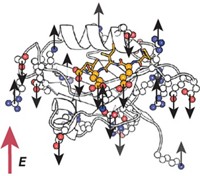Advertisement
Grab your lab coat. Let's get started
Welcome!
Welcome!
Create an account below to get 6 C&EN articles per month, receive newsletters and more - all free.
It seems this is your first time logging in online. Please enter the following information to continue.
As an ACS member you automatically get access to this site. All we need is few more details to create your reading experience.
Not you? Sign in with a different account.
Not you? Sign in with a different account.
ERROR 1
ERROR 1
ERROR 2
ERROR 2
ERROR 2
ERROR 2
ERROR 2
Password and Confirm password must match.
If you have an ACS member number, please enter it here so we can link this account to your membership. (optional)
ERROR 2
ACS values your privacy. By submitting your information, you are gaining access to C&EN and subscribing to our weekly newsletter. We use the information you provide to make your reading experience better, and we will never sell your data to third party members.
Biological Chemistry
Enzyme Catalysis Is A Moving Experience
Enzymology: Not only do enzymes accelerate reactions, they propel themselves around
by Stu Borman
December 11, 2014
| A version of this story appeared in
Volume 92, Issue 50

Enzymes have been studied for more than a century, but a new study reveals an aspect of their behavior that has gone almost completely unrecognized until now. The research shows that enzymes are pushed around in solution by forces generated by the reactions catalyzed in their active sites.
The work shines a light on a basic but unappreciated aspect of enzyme behavior. It could lead to a better understanding of the way motor proteins move around and could aid scientists designing synthetic enzymes to do useful work in cells.
The idea that enzymes push themselves around in cells originated with Ayusman Sen, Peter J. Butler, and coworkers at Pennsylvania State University. In the past few years, they have shown that enzymatic reactions increase the movement of enzymes in solution. But the reason for the behavior has been elusive.
Carlos Bustamante and Susan Marqusee of the University of California, Berkeley; Steve Pressé of Indiana University-Purdue University Indianapolis; and coworkers have now found the underlying cause of the phenomenon (Nature 2014, DOI: 10.1038/nature14043). They carried out a single-molecule fluorescence correlation spectroscopy study of four enzymes: catalase, urease, alkaline phosphatase, and triose phosphate isomerase. The study shows that the four enzymes’ diffusion rate in solution depends on the amount of heat generated by the catalyzed reaction.
Each time an enzyme catalyzes a reaction, the enzyme gives itself a little kick, the team finds. In more than a century of enzyme kinetics studies, “this effect was missed because, through most of this time, enzymes have been studied in bulk, not as single molecules,” Bustamante says.
The work “adds to our general understanding of enzyme catalysis by challenging the usual idea that enzymes remain unperturbed by the heat generated by reactions in their active sites,” notes enzyme kinetics expert Athel Cornish-Bowden of France’s National Center for Scientific Research and Aix-Marseille University.
Pressé, Bustamante, Marqusee, and coworkers believe that waves of heat energy generated by each active-site reaction exert forces at the enzyme’s outer surface that cause the enzyme to move in specific directions. To cause displacement, the active site must be at an offset position in the enzyme’s structure. If it were dead center in a theoretically spherical enzyme, the waves would reach all points at the enzyme’s outer surface simultaneously and directional forces would cancel each other.
The researchers speculate that the heat from each reaction event may also cause partial unfolding or other conformational changes in the structure of enzymes. Such changes could control enzyme turnover rates because enzymes might need a specific amount of time to recuperate from each deformation before catalyzing subsequent reaction events.
“The study tells us that to make artificial enzymes, it is important not just to design the active site but also the overall response of the protein scaffold to the heat of reaction,” Bustamante says.
Penn State’s Sen comments that the study “could lead to the design of synthetic motor proteins and enzyme-powered robots that can actively transport bioactive agents in living systems, including targeted drug delivery.”
Along with the earlier Penn State studies, Butler says the new study “provides a way forward for probing the local environment of single enzymes at the moment of reaction.”





Join the conversation
Contact the reporter
Submit a Letter to the Editor for publication
Engage with us on Twitter